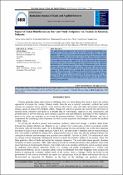Options
Impact Of Zakat Distribution On Poor And Needy Recipients: An Analysis In Kelantan, Malaysia
Journal
Australian Journal of Basic and Applied Sciences
Date Issued
2013
Author(s)
Ahmad Fahme Mohd Ali
Zaleha binti Mohd Noor
Muhammad Ridhwan Ab Aziz
Fuadah Johari
Abstract
This study attempts to examine the effectiveness of monthly zakat distribution as a mechanism to poverty reduction in the state of Kelantan, Malaysia. The target population of this study is the poor and needy zakat recipient of the Kelantan Zakat Department, (MAIK). 481 respondents were randomly selected from Kelantan’s zakat recipient’s list from the poor and needy category for ten districts of Kelantan. In depth interview were used to gather the data. For analysing the data, descriptive statistics were applied. Results indicate that zakat elasticity is about 0.46, suggesting that, holding other variables constant, if the zakat distribution goes up by 1 per cent, the monthly income goes up by 0.46 per cent. Further, the male coefficient is about 0.15, meaning that the male gender receives about 0.15 per cent more income compare to female gender, again holding other variables constant. Thus, zakat distribution is significant in determining the income distribution among this group and bringing positive effect towards improving the income distribution of this group. Thus, these statistical measures have proven the positive role of zakat in reducing poverty among the Poor and needy and once again prove our result from previous poverty measures.
File(s)
Loading...
Name
Impact Of Zakat Distribution On Poor And Needy Recipients.pdf
Description
Impact of Zakat Distribution on Poor and Needy Recipients: An Analysis in Kelantan, Malaysia
Size
112.24 KB
Format
Adobe PDF
Checksum
(MD5):87d7d8578a85c8e1a2f1dc35fb83035d